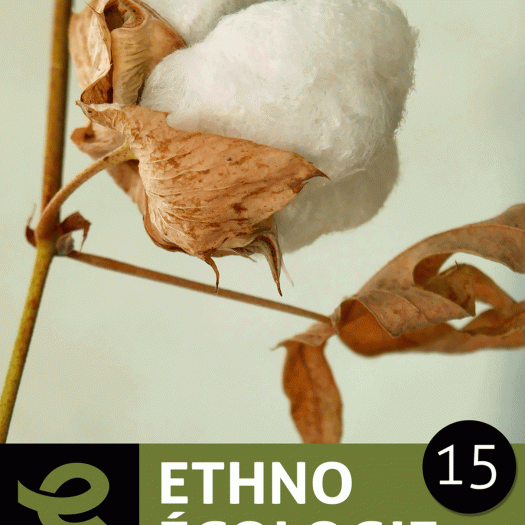Coton de l’Ancien Monde : domestication, culture, usages et échanges



Le dernier numéro de la Revue d’Ethnoécologie est consacré à l’histoire du coton.
Revue d’Ethnoécologie [En ligne], 15 | 2019, mis en ligne le 30 juin 2019
https://journals.openedition.org/ethnoecologie/4063
Sous la direction de Charlène Bouchaud et Elsa Yvanez
Le coton (Gossypium sp.) est un symbole éloquent de la mondialisation moderne, évoquant tout à la fois la matière douce dominant l’industrie textile et des désastres écologiques et sociaux planétaires. Son internationalisation n’est cependant pas le résultat d’un processus récent et son histoire, impliquant quatre espèces domestiquées, forme un témoignage vibrant de la circulation des savoirs, des biens et des personnes. Le coton est ainsi un cas d’étude exemplaire d’histoire globale, requérant la convergence de différents points de vue. Tendant vers cet objectif, ce volume réunit les travaux présentés lors d’un colloque interdisciplinaire tenu en 2017 au Muséum d’Histoire Naturelle (https://gossypium.sciencesconf.org/).Les chercheurs qui y ont contribué viennent de différents champs disciplinaires, tour à tour spécialistes en génétique, histoire, archéologie, archéobotanique, études des textiles, anthropologie sociale et linguistique, et tous partageant un intérêt commun pour le coton. Les articles offrent ainsi un panorama des connaissances sur les processus de domestication, d’émergence et de diffusion du coton et de ses produits – fibres, graines, huile, et textiles – dans l’Ancien Monde, de l’Asie à l’Afrique, durant les trois derniers millénaires.
Today, cotton (Gossypium sp.) is an eloquent symbol of modern globalisation, conjuring images of both a soft material dominating the textile market and social and environmental disasters of global magnitude. Its internationalisation however is not the result of a recent process: the history of cotton and its four domesticated species shows one of the most outstanding examples of the circulation of knowledge, goods and people. Cotton is therefore a perfect case study for Global History, requiring the meeting of different points of view. With this aim in mind, the present volume brings together studies presented during a conference organised in 2017 at the Museum of Natural History in Paris (https://gossypium.sciencesconf.org/). Contributing scholars come from different scientific fields, such as genetic, history, archaeology, archaeobotany, textile studies, anthropology, and linguistics, but all share a common interest in cotton. The papers offer an overview of the available knowledge on the domestication, emergence and diffusion of the cotton plant and its various products – fibres, seeds, oil, and textiles– in the Old World, from Asia to Africa, over the last three millennia.
- Charlène Bouchaud, Elsa Yvanez et John Peter Wild
Tightening the thread from seed to cloth. New enquiries in the archaeology of Old World cotton - A case for inter-disciplinarity
Tendre un fil de la graine à l’habit. Nouvelles recherches sur l’archéologie du coton dans l’Ancien Monde : l’apport de l’interdisciplinarité
- Christopher Viot
Domestication and varietal diversification of Old World cultivated cottons (Gossypium sp.) in the Antiquity
Domestication et diversification variétale des cotons cultivés (Gossypium sp.) de l’Ancien Monde dans l’Antiquité
- Louise Quillien
Dissemination and price of cotton in Mesopotamia during the 1st millennium BCE
Dissémination et prix du coton en Mésopotamie pendant le ier millénaire BCE
- Elsa Yvanez et Magdalena M. Wozniak
Cotton in ancient Sudan and Nubia - Archaeological sources and historical implications
Le coton en Nubie et au Soudan anciens : sources archéologiques et implications historiques
- Fleur Letellier-Willemin
Le coton à El Deir - Premières observations sur l’existence d’une nouvelle fibre textile dans l’oasis de Kharga (désert occidental égyptien, ve siècleAEC-ve siècle EC)
Cotton at el-Deir. First observations on a new textile fibre in the Kharga oasis (Egyptian Western desert, 5th century BCE-5th century CE)
- Orit Shamir
Cotton textiles from the Byzantine period to the Medieval period in ancient Palestine
Textiles de coton en ancienne Palestine, de l’époque byzantine à l’époque médiévale
- Jean-Charles Ducène
Le coton, sa culture et son utilisation selon les sources arabes médiévales
The cultivation and uses of cotton in medieval Arab sources
- Lucie Smolderen
Des graines, des fibres et des bobines - Mémoire d’une filière textile artisanale dans le Dendi (Nord Bénin)
Seeds, fibres and bobbins. Memoirs of a textile craft in Dendi, North Benin
- Christian Seignobos
Du coton traditionnel au coton colonial, le coup de force du progrès (Nord-Cameroun)
From traditional to colonial cotton: the coup de force of progress in North Cameroon